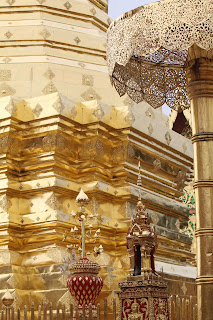Thursday, January 31, 2013
Wat Phra That Doi Sethup
Today's adventure was based on our decision to spend a day with a driver out and about exploring Chiang Mai. We booked Yo for the day, the driver who we had from the airport to the hotel. He speaks passable English, and has a sense of humour so we figured we would enjoy his company for the day. Being born in Chiang Mai he was bound to know some special points of interest.
We had arranged to meet Yo at 9.00am and when we went up to reception we passed the water buffalo out for their morning constitutional. After reading about them in the hotel brochure it was nice to see them. After a quick pat and photo it was off in the car.
We decided to visit the Doi Suthep area first. A large National Park at the top of a mountain it is popular for trekking, bird watching and as the site of a famous temple. With the torrential rain the night before we figured bird watching and trekking might be hard going so we settled on the temple.
Wat Phra That Doi Suthep is one of the most revered Buddhist sites in Thailand. Being mid week, and initially overcast, the usual number of tourists was less than normal which was a bonus.
Access to the temple is via a cable car which takes 2 minutes, or you can walk the dragon staircase which takes 15 minutes and lots of stamina. Being sensible we rode up, then walked down. The dragon staircase has beautiful ceramic panels simulating "scales" as the hand rails beside the stairs. Well worth seeing.
As a sign of respect, all shoes must be removed before entering the temple. As you enter you must step over the doorway, not on the door step, as spirits live here and you don't want to awaken them.
The temple complex boasts many murals within the cloisters depicting scenes from Buddha's life. The central "chedi" or dome is stunning in pure gold. Gold leaf is available for pilgrims to purchase to add to elements around the temple as they desire by means of earning merit.
The local Thai people will walk around the chedi three times, holding what I think is a lotus flower, while saying prayers. They have a special little area fenced off from the main thoroughfare around which they walk. There are also points outside this area where you can stop and pray.
To enter any of the side prayer rooms is acceptable, so long as you lower your head below any Buddha within the room. As the representative of Buddha you must also remain lower than any Monk. They are generally seated on a raised platform, and you kneel respectfully before them. Another fact of interest, you must never point your feet towards Buddha, hence you kneel before the enlightened one, with feet neatly tucked facing away.
A highlight of our visit was being blessed by the Monk. Without the appropriate language skills this was less about religion than a calm, emotive experience. With heads bowed we were flicked with water, the Monk prayed, ending with "happy happy life, luck" or something to that effect. A happy way to end a prayer in any language.
Sai sin is the name of the white thread given to us at the temple. They are tied on to your wrist and signify safety, health and good fortune. The Monk applies the sai sin to men, however being unable to touch women, an assistant will tie them on for women. Frank received an extra personal blessing from the Monk as he had his sai sin tied on. It seems that the point of removal of the sai sin is up to the individual, although you must not remove them immediately or while at the ceremony in which they were applied. This tends to be for temple visits, blessings for major purchases and family celebrations, funerals etc. Auspicious points for removal seem to be three or nine days after application, or just let them wear off naturally.
30.1.2013
Subscribe to:
Post Comments (Atom)












No comments:
Post a Comment